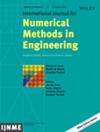DCEM: A deep complementary energy method for linear elasticity
IF 2.7
3区 工程技术
Q1 ENGINEERING, MULTIDISCIPLINARY
International Journal for Numerical Methods in Engineering
Pub Date : 2024-09-13
DOI:10.1002/nme.7585
引用次数: 0
Abstract
In recent years, the rapid advancement of deep learning has significantly impacted various fields, particularly in solving partial differential equations (PDEs) in the realm of solid mechanics, benefiting greatly from the remarkable approximation capabilities of neural networks. In solving PDEs, physics‐informed neural networks (PINNs) and the deep energy method (DEM) have garnered substantial attention. The principle of minimum potential energy and complementary energy are two important variational principles in solid mechanics. However, the well‐known DEM is based on the principle of minimum potential energy, but it lacks the important form of minimum complementary energy. To bridge this gap, we propose the deep complementary energy method (DCEM) based on the principle of minimum complementary energy. The output function of DCEM is the stress function, which inherently satisfies the equilibrium equation. We present numerical results of classical linear elasticity using the Prandtl and Airy stress functions, and compare DCEM with existing PINNs and DEM algorithms when modeling representative mechanical problems. The results demonstrate that DCEM outperforms DEM in terms of stress accuracy and efficiency and has an advantage in dealing with complex displacement boundary conditions, which is supported by theoretical analyses and numerical simulations. We extend DCEM to DCEM‐Plus (DCEM‐P), adding terms that satisfy PDEs. Furthermore, we propose a deep complementary energy operator method (DCEM‐O) by combining operator learning with physical equations. Initially, we train DCEM‐O using high‐fidelity numerical results and then incorporate complementary energy. DCEM‐P and DCEM‐O further enhance the accuracy and efficiency of DCEM.DCEM:线性弹性的深层能量互补法
近年来,深度学习的快速发展对各个领域产生了重大影响,特别是在固体力学领域的偏微分方程(PDE)求解方面,神经网络的卓越逼近能力使其受益匪浅。在求解偏微分方程方面,物理信息神经网络(PINNs)和深度能量法(DEM)受到了广泛关注。最小势能原理和互补能原理是固体力学中两个重要的变分原理。然而,众所周知的 DEM 基于最小势能原理,却缺少最小补能这一重要形式。为了弥补这一缺陷,我们提出了基于最小互补能原理的深度互补能方法(DCEM)。DCEM 的输出函数是应力函数,它本质上满足平衡方程。我们利用普朗特和艾里应力函数展示了经典线性弹性的数值结果,并将 DCEM 与现有的 PINNs 和 DEM 算法在模拟代表性机械问题时进行了比较。结果表明,DCEM 在应力精度和效率方面优于 DEM,并且在处理复杂位移边界条件时更具优势,这一点得到了理论分析和数值模拟的支持。我们将 DCEM 扩展为 DCEM-Plus (DCEM-P),增加了满足 PDE 的项。此外,通过将算子学习与物理方程相结合,我们提出了一种深度互补能量算子方法(DCEM-O)。最初,我们使用高保真数值结果训练 DCEM-O,然后加入互补能量。DCEM-P 和 DCEM-O 进一步提高了 DCEM 的精度和效率。
本文章由计算机程序翻译,如有差异,请以英文原文为准。
求助全文
约1分钟内获得全文
求助全文
来源期刊
CiteScore
5.70
自引率
6.90%
发文量
276
审稿时长
5.3 months
期刊介绍:
The International Journal for Numerical Methods in Engineering publishes original papers describing significant, novel developments in numerical methods that are applicable to engineering problems.
The Journal is known for welcoming contributions in a wide range of areas in computational engineering, including computational issues in model reduction, uncertainty quantification, verification and validation, inverse analysis and stochastic methods, optimisation, element technology, solution techniques and parallel computing, damage and fracture, mechanics at micro and nano-scales, low-speed fluid dynamics, fluid-structure interaction, electromagnetics, coupled diffusion phenomena, and error estimation and mesh generation. It is emphasized that this is by no means an exhaustive list, and particularly papers on multi-scale, multi-physics or multi-disciplinary problems, and on new, emerging topics are welcome.

 求助内容:
求助内容: 应助结果提醒方式:
应助结果提醒方式:


